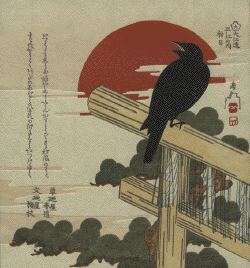This is the 35th issue of 'Hyakunin Issho', and as you have already seen, the cover design has changed. The 100 little numbers have gone, and have been replaced by ten empty circles. These circles will gradually fill up during the course of this coming year, as the ten prints of my new series are finished one by one. Yes, after completing that ten year project, this next set of prints will only take one year!
Maybe.
I'd better start at the beginning.
About a year ago, when the end of my 'One Hundred Poets' woodblock print series started to come closer, many ideas for future work presented themselves to me; there are many thousands of beautiful prints and books preserved in the museums of the world, just waiting to be brought to life again. The problem for me was not one of finding something to do, but of choosing among so many attractive alternatives.
I browsed through volume after volume of print illustrations and various history books, and although I saw many beautiful prints, over and over again I found myself coming back to the surimono prints that I saw.
Surimono are a 'sub category' of traditional Japanese woodblock prints. Unlike the more famous ukiyo-e, which were produced with the intention of being distributed as widely as possible, surimono were privately published works, used for gifts or sometimes for making announcements, and were almost never sold to the general public.
The most common type of surimono (the term translates simply as 'printed thing') were prints like the one you see illustrated here, containing a blend of image and poetry, usually of the kyoka type. Such prints were commissioned by the poets themselves, and were exchanged among the members of their poetry 'circle'. Because no commercial motives were involved, purely artistic factors were allowed to dominate economics in their manufacture. The finest papers and pigments were used, top rank craftsmen were commissioned to do the carving and printing, and the best artists were asked to produce the designs. Surimono were usually fairly small in size, with 19 x 21.5 cm being the most common dimension.
They came into being in about the 1760's, and lasted some hundred years or so. Most of the well-known artists of the day were asked to design surimono at one time or another, and some men specialized in the work. Many different themes were used for surimono imagery, among which historical events, scenes from nature, 'still-life', and the kabuki theatre were the most common.
As I looked at the book illustrations of surimono prints, and saw the fine carving, the indescribably delicate printing - I knew that here was my next theme. For ten years I have been making prints all designed by one person, all depicting one theme - the Hyakunin Isshu. But I realized that my next project did not have to be quite so limited - my new theme could be the beauty of woodblock prints themselves! I could use my skills to make prints like this - to show as many people as possible just how incredibly beautiful woodblock prints can be. I could create a new definition for the word surimono - retaining the original concept of prints of indescribable beauty and delicacy, but broadening the idea somewhat, to include such illustrations as book pages and other images that hadn't originally been privately published prints.
I started to gather clippings and notes about those prints that seemed particularly attractive to me, and soon discovered that the pile grew very rapidly. The only common thread among the prints in this 'collection', was that I personally found them attractive. There was no other underlying theme or link between them. Some were simple and fairly straightforward, others were more complex and would need a very high level of skill to reproduce.
I picked out ten that most attracted me, laid them out in a row, and thought about the idea ... the idea of publishing my own album of surimono. I could make one each month, just the same as I had done during the years of the poets series, and could send them out to print lovers and collectors one by one as they were finished (with a storage case for the set sent along with the first print). And of course I would continue the practice of having an annual exhibition each January to show my work.
The idea snowballed in my mind, and after many months of preparation, I announced the new series at the recent exhibition. The reaction from viewers was excellent, and work on the first album is now under way. I say 'first' album, because of course, I don't plan on stopping at ten. With such an embarrassment of riches to choose from, I could easily make a new album every year for the next hundred years! Well that of course won't happen, but just how far I will carry this series remains to be seen. Perhaps later on I will find another theme to be more attractive to me, and will switch. Or perhaps this Surimono Album series will be my 'final' theme ... We'll see ...
The surimono of the 18th and 19th century reached astonishing heights of beauty. Since those days, the genre has been 'asleep', but perhaps it yet has some life left in it. Surimono though, cannot be made on a 'get it done, and get it out the door' principle. They can only be produced by an 'amateur' - and I use that word in its original French meaning ... one who loves.
I am a surimono 'amateur'. I hope you will enjoy the prints I make.
